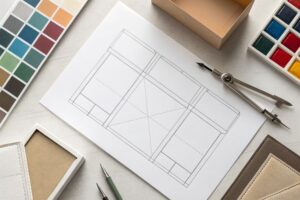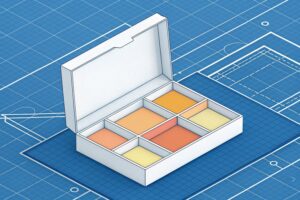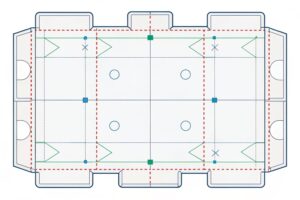What About the Disadvantages of Corrugated Boxes?

You love the price and speed of corrugated boxes. Then dents, moisture, and short shelf life show up. I map the downsides and show simple fixes that save launches.
Corrugated boxes have clear weaknesses: moisture sensitivity, crush under point loads, scuffing in transit, variable quality between mills, limited long-term rigidity, and faster aging; smart grade selection, coatings, and structural design reduce these trade-offs.

I run PopDisplay in Shenzhen with three lines. I make cardboard displays for tight retail calendars in the US, Canada, the UK, and Australia. I test. I fail. I learn. I share the simple rules that keep timelines safe, even when budgets stay tight.
What are the disadvantages of corrugated boxes?
Many teams meet corrugated late, when a retail date is fixed. They assume it behaves like plastic or metal. It does not. It bends, absorbs, and crushes if loads are sharp or wet.
Main drawbacks include moisture sensitivity, weak edges, crush under straps or point loads, limited long-term rigidity, print scuffing, and inconsistent board quality across suppliers and batches; each risk is manageable with the right spec and tests.

Common failure modes I see
Water kills fibers first. Edges lose strength. A narrow strap makes a knife on the panel. A heavy SKU rests on two tiny feet and makes a dent that grows. Gloss inks look great but scuff during back-haul. Pallet overhang reduces crush strength by a lot. These patterns repeat in food, beauty, and hardgoods. I learned them on a floor display for an outdoor brand with alloy shafts. Week one was fine. Week three sagged because the feet concentrated load. We changed the base to a full platform and added a PET liner. The display finished the season.
Where these risks hit your project
| Weakness | Why it happens | Risk on displays | Mitigation I use |
|---|---|---|---|
| Moisture gain1 | Fibers wick water | Warp, soft walls | AQ/Poly coating, nano-spray, shrink overwrap, store dry |
| Point load crush2 | Load on small area | Dents under heavy SKUs | Full base, load spreaders, double-wall at feet |
| Edge weakness | Cut exposes flutes | Split at tabs | Reinforce tabs, longer locks, tape at stress points |
| Scuffing | Ink rubs in transit | Dirty branding | High-rub varnish, pack sleeves, nested stacking |
| Batch variance | Pulp mix changes | Surprise failures | ECT/BCT incoming tests, approved mill list |
| Long display life | Creep over time | Lean, bow, tilt | Over-spec posts, foam cores, schedule refresh windows |
The point is simple. Corrugated works if you design for its limits before the clock starts. I do that on every brief now.
What are the disadvantages of corrugation?
Teams love the cushion of flutes. They forget that voids reduce surface hardness. A smoother board prints better, but it often stacks worse. Every flute choice moves a lever.
Corrugation adds cushioning but reduces density, edge hardness, and puncture resistance; flute choice sets trade-offs between stacking strength, print smoothness, die-cut accuracy, and cost, so poor matching leads to crush, washboard print, or fit issues.

The material science reality
Flutes trap air. That air cushions drops. It also lowers panel density. Lower density means lower puncture and edge tear. Tall flutes (like C) give better stacking but worse print smoothness. Short flutes (like E or F) print clean but buckle sooner. Micro-flutes cut sharply, yet they hate humidity spikes. Double-wall adds stiffness, yet it adds score cracking risk on tight folds. These are not flaws. They are trade-offs. When I onboard a new buyer, I walk through a board wall and press each sample so the team feels these changes by hand.
Engineering choices you must state in the spec
| Flute/Build | Pros | Cons | Best for |
|---|---|---|---|
| B flute | Good stacking, decent print | Some washboard, mid weight | Floor trays, PDQ shippers |
| C flute | Strong stacking | Rougher print, bigger kerf | Outer cartons, pallet skirts |
| E flute | Smooth print, crisp die-cuts | Lower BCT, puncture risk | Countertops, sleeves, small trays |
| BC double-wall | Very stiff, tall stacks | More cost, harder folds | Tall columns, heavy SKUs |
| BE double-wall | Stiff + decent print | Score crack risk | Premium floors with graphics |
Also set limits for score-to-cut, minimum tab length, and slot width. These small numbers decide if a store team can build a unit fast. I publish a one-page “corrugation checklist3” in every project so no lever sits hidden. When we do this, rejects fall, installs speed up, and brand teams stop firefighting.
How long do corrugated boxes last?
People ask for a single number. There is no single number. Life depends on humidity, load, handling, coatings, storage, and grade. I plan for the shortest window and then add margin.
Most corrugated boxes last weeks to months in use; lifespan changes with humidity, stacking pressure, handling, coatings, and board grade; plan conservatively, test BCT/creep, and add protection where the environment is harsh.
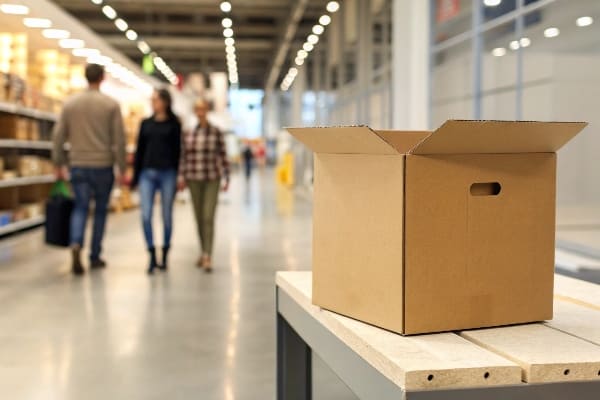
What sets the service life
Time and moisture do more damage than most drops. Paper loses stiffness as humidity rises. Constant load causes creep. That slow bend looks small on day two and big on day 30. A water-based varnish4 helps scuff but not long humidity. A poly coat blocks water but can hurt recycling if overused. Indoor retail displays with heavy gear often look tired after 8–12 weeks. Dry backroom storage can hold flat packs for 6–12 months if the wrap stays sealed. I once ran a gun case display for a US hunting brand with strict dates. We used BE double-wall, PET feet, and a top wrap. The units stayed straight through a 12-week season. The control group without feet sagged by week five.
Practical timelines I use as a starting point
| Environment | Typical life | Notes | My rule |
|---|---|---|---|
| Sales floor, heavy SKUs | 8–12 weeks | Creep, scuff | Over-spec posts and base |
| Sales floor, light SKUs | 12–16 weeks | Visual wear first | Add edge tape, rotate stock |
| Dry warehouse, sealed | 6–12 months | Flat packs | Keep off floor, no overhang |
| Humid warehouse | 1–3 months | Box soften | Use poly bag, desiccant |
| Cold chain or damp | Days–weeks | Water shock | Switch to coated or hybrid |
Use these as planning ranges. Then run a test stack for two weeks at target humidity. I run ECT, BCT, and a creep check with data loggers so the argument turns into numbers, not hope.
Is corrugated cardboard bad for the environment?
I hear two claims. “It is green.” “It is not green.” Both miss detail. It is recyclable and renewable. It still uses trees, water, energy, and coatings. Design choices decide the impact.
Corrugated is widely recyclable and from renewable fiber, but impacts rise with virgin pulp, water and energy use, long freight, plastic films, and contaminated waste; good specs, recycled content, and clean recovery keep its footprint low.
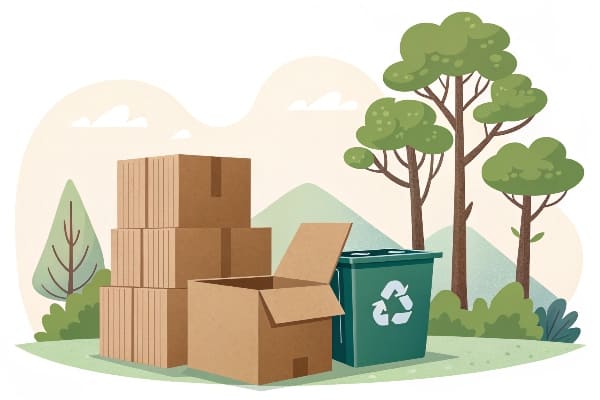
The real footprint and how I cut it
Recycled content lowers tree use and energy. But very high recycled content can reduce strength, so you may add weight and lose the gain. Water-based inks are good, yet heavy gloss films hurt recovery. Wet-strength resins and hot-melt labels complicate pulping. Extra foam or hard plastic hooks can block single-stream lines. Over-engineering adds board that no one needs. Under-engineering causes reprints and re-shipments, which are worse. My rule is simple. I design to the lightest spec that still survives the route and the floor. I keep coatings minimal and purposeful. I write the recycling note on the unit, and I avoid mixed materials where I can. When a US buyer asks for proof, I share mill certificates, FSC options, and a one-page recycling guide that the store staff can scan.
What to check before you print
| Impact area | What hurts | Practical fix | Buyer question to ask |
|---|---|---|---|
| Fiber source | Virgin-only pulp | Use high PCR5 where strength allows | “What % recycled can we use?” |
| Coatings | Heavy films, mixed laminates | Use water-based varnish6 or thin PET only where needed | “Can we protect hotspots only?” |
| Logistics | Air gaps, overhang, re-ships | Flat-pack, tight pallets, no overhang | “How do we pack to reduce damage?” |
| End of life | Wet, dirty, mixed parts | Clear labels, simple disassembly | “Will a clerk recycle this fast?” |
Good design keeps the brand safe and the planet in mind. That balance is the real work. I do it on every brief because buyers reward it and waste drops.
Conclusion
Corrugated is strong when we respect its limits. Plan for water, points, time, and prints. Specify, test, and protect the weak spots. Then launch on time with less waste.
Understanding moisture gain is crucial for preventing warping and ensuring the longevity of your displays. ↩
Learn effective strategies to avoid point load crush, which can lead to significant damage in your displays. ↩
A corrugation checklist can streamline your packaging process, reducing errors and improving efficiency. ↩
Explore the advantages of water-based varnish for protecting surfaces and enhancing durability in various environments. ↩
Understanding high PCR can help you make informed choices about sustainable materials and their impact on the environment. ↩
Exploring the benefits of water-based varnish can enhance your knowledge of eco-friendly printing options and their advantages. ↩

